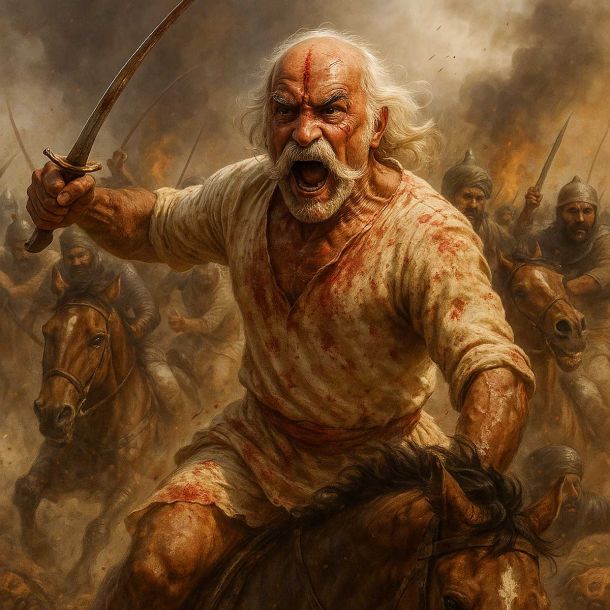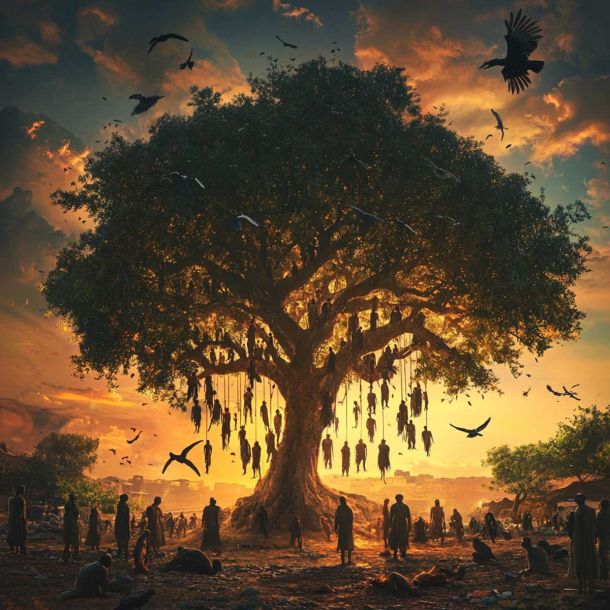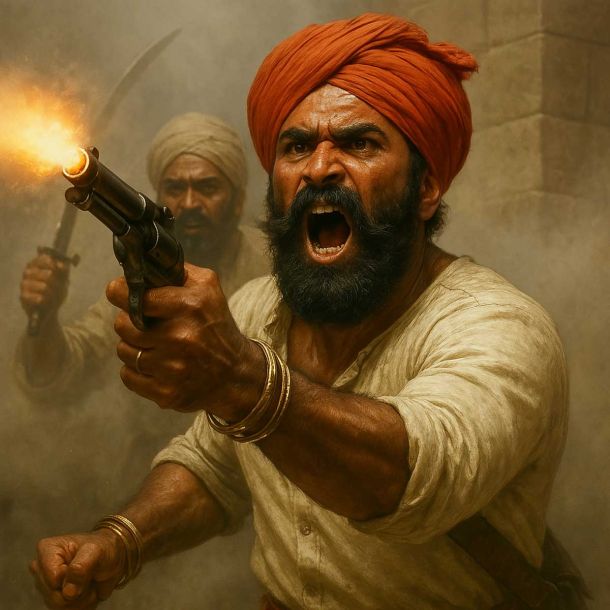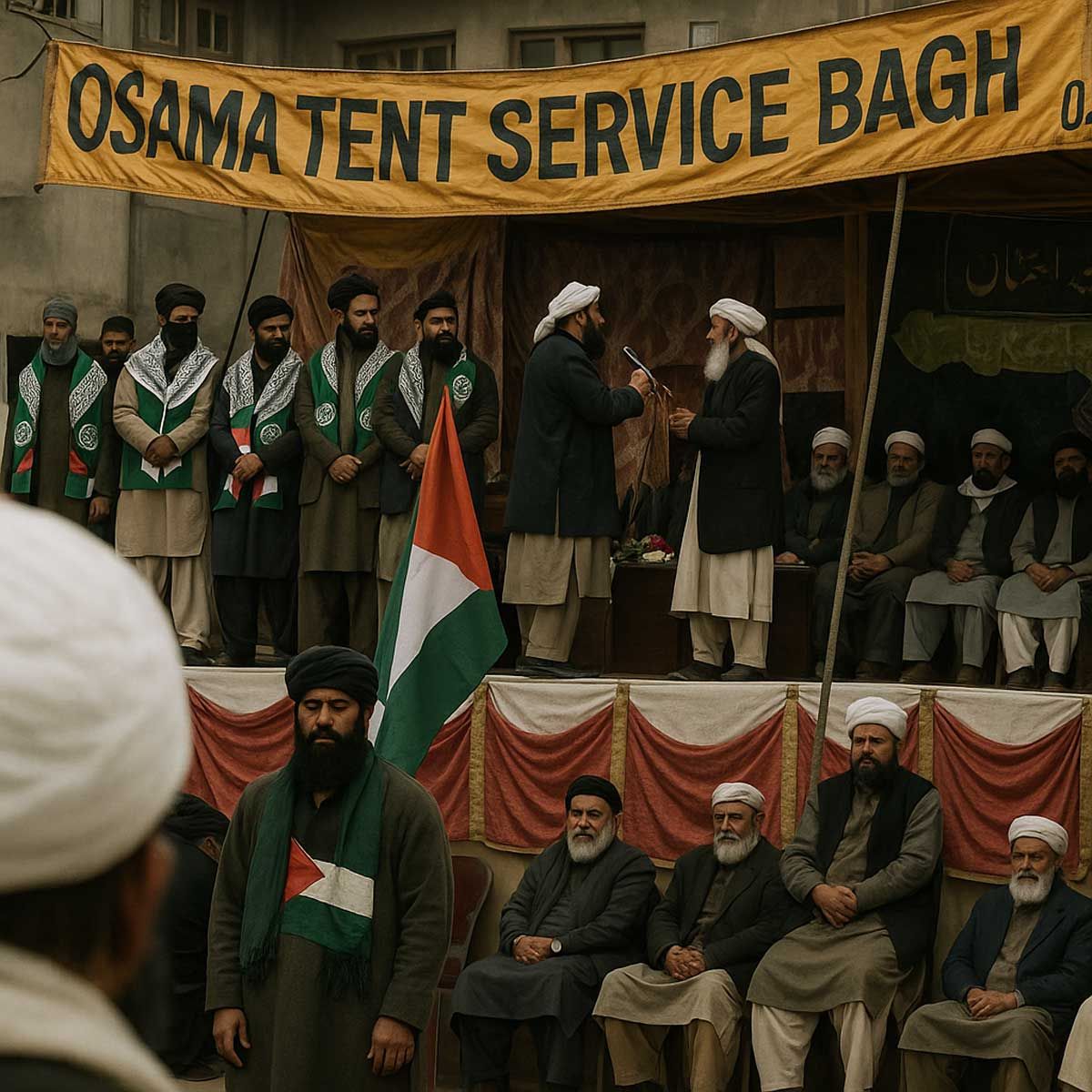Sanatan Articles
Satyaagrah
Written on
Satyaagrah
Written on
Satyaagrah
Written on
Satyaagrah
Written on
Satyaagrah
Written on
JOIN SATYAAGRAH SOCIAL MEDIA
“It is not the honor that you take with you, but the heritage you leave behind”: Greek historian Megasthenes' Indica provides a historical account of ancient India, offering glimpses into its geography, society, governance, religion, economy, and culture

India’s rich history has been distorted by many fake and communist historians. However, in ancient times many national and international scholars, and scientists demonstrated that India was great in all aspects, including socially, economically, scientifically, technologically, and spiritually. One of them was the Greek philosopher Megasthenes.
Many historians, primarily communists, wrote Indian history with the malicious intent of proving that communism is the ultimate ideology for the simple reason of selfishness that satisfied their personal desires at the cost of millions of lives and threw the majority of followers in the worst conditions. Their hatred for Bharatiya culture and “Bharatiyatva” drove them to distort history, causing Indians to develop a hatred for their own culture and feel bad about their own culture, knowledge, and ancient history.
With a long history of invasion and colonialism, Indians are accustomed to viewing themselves through the eyes of the “other,”, especially in an English-centered universe. 400 years of Eurocentrism has distorted our perception of ourselves. However, it is worth noting that India’s contacts with the outside world date back much further; to thousands of years ago, during the times of the civilization on the banks of the Sindhu and the Saraswati, and they have been sources of its function as a cradle of universal ideas.
The fake Aryan Invasion theory, twisted Epic Ramayana and Mahabharata stories, changing the facts about great warriors and freedom fighters like Chhatrapati Shivaji Maharaj, and portraying invaders and looters as great personalities have all been used to brainwash the people in order to sow discord, and divide people, and break the nation. Greece, Rome, and Iran all lost their culture and identity, but India, despite more than 200 attacks and invasions, is still strong in culture, identity, and unity as a nation. Fake historians must accept that the principles of Sanatan Dharma are useful not only for India but for the entire world.
However, ancient work on the ground, scientific discoveries such as DNA analysis, archaeological facts, and in-depth study and analysis by many national and international scholars, scientists demonstrated that India was great in all aspects, including socially, economically, scientifically, technologically, and spiritually.
Megasthenes, a Greek historian and diplomat, visited India during the 4th century BCE and wrote an extensive account of his observations in a work called "Indica." This text provides valuable insights into the ancient Indian civilization, its culture, society, and governance. Although the original work is lost, fragments and excerpts from Indica have survived in the writings of later historians, such as Strabo and Arrian.
- Megasthenes, a Greek philosopher, wrote one of the most ancient works based on personal experience and knowledge.
- He was a Greek diplomat, historian, and ethnographer whose extensive writings on Indian cultures provided insight into the lives of ancient Indians during Chandragupta Maurya’s rule.
- Although his book, the Indica, was lost in the passage of time, it has been partially reconstructed using literary sources from later authors.
- Indika, based on Hekataios’ Aegyptiaka, was written in either the Attic or Ionian dialects and was divided into four sections.
- Megasthenes documented India’s soil, climate, animals, plants, government, religion, people’s manners, arts, and so on. In a nutshell, it’s a detailed description of the king of the most remote tribe.
For one thing, it is the earliest surviving and most comprehensive description of Ancient India by a foreign visitor—the first in a line of visitors such as Fa Hien, Hiuen Tsang, and Al-Biruni who have provided valuable insights into the country’s position at the time. Indika’s influence on other Roman and Greek writers, as well as their scientific knowledge, has been enormous, aside from its role as an invaluable resource for Indian antiquity.
Indica, based on Hekataios’ Aegyptiaka, was written in either the Attic or Ionian dialects and was divided into four sections. Megasthenes documented India’s soil, climate, animals, plants, government, religion, people’s manners, arts, and so on. In a nutshell, it’s a detailed description from the king to the most remote tribe.
For one thing, it is the earliest surviving and most comprehensive description of Ancient India by a foreign visitor—the first in a line of visitors such as Fa Hien, Hiuen Tsang, and Al-Biruni who have provided valuable insights into the country’s position at the time. Indika’s influence on other Roman and Greek writers, as well as their scientific knowledge, has been enormous, aside from its role as an invaluable resource for Indian antiquity.
Indian soil is rich in gold, silver, copper, and iron. Tin and other metals are used to create a variety of tools, weapons, ornaments, and other items. India has very fertile plains, and irrigation is widely practised. Rice, millet, a crop called bosporum, cereals, pulses, and other food plants are the main crops. Aside from Megasthenes’ discoveries, scientific knowledge in Vedas, complex temple structures, metallurgical discoveries, town planning, civil engineering concepts, thermodynamics, and astronomy demonstrate the scientific and technological temperament at the time.
Because of its size, India is home to many different races, all of which are indigenous. India has no foreign colonies, and Indians have no colonies outside of India. Slavery is prohibited by law, as prescribed by ancient Indian philosophers. Everyone is treated equally under the law. The breaking Indian forces created a bogus Aryan invasion theory to portray Bharatiyas as invaders who attacked Dravidians; this theory was not only rejected by Megasthenes, but scientific evidence from DNA analysis and archaeological findings proved it incorrect.
|
According to the Indika, society was divided into seven classes: sophists or philosophers, overseers, farmers, herders, artisans, soldiers, and councillors. Historians later attempted to connect this to “caste” in India, but this has serious flaws. Although endogamy was a feature of these classes, admission was not based on birth, and no mention of the four varnas is made. This could be interpreted as providing some support for the understanding of caste in Ancient India as a more fluid concept than conventional commentators’ concept. This clearly demonstrates that caste-based discrimination was not a feature of Indian civilization. It was designed to divide society; however, people became trapped, and caste-based narratives continue to harm society and the nation.
“The residents, in like manner, having abundant means of living, exceed in consequence the ordinary social standing and are distinguished by their proud bearing. They are also found to be skilled in the arts, as one would expect of men who breathe pure air and drink only the finest water. And, while the soil bears on its surface all kinds of cultivable fruits, it also comprises numerous veins of various metals underground.” They dislike a large, disorderly crowd and, as a result, they maintain good order. Theft is extremely uncommon. According to Megasthenês, those who were in the camp of Sandrakottos, which housed 400,000 men, discovered that the thefts reported on any given day did not exceed the value of two hundred drachmes, and this among a people with no written laws. They live happily enough, despite being simple and frugal in their manners. The fact that they rarely go to court attests to the simplicity of their laws and contracts. Their homes and property are generally unguarded. This demonstrates the high moral values practised at the time; however, as we have started following European culture, the majority of us have forgotten the moral values as greed and selfishness have taken over.
Pataliputra’s municipal administration is detailed, with six committees of five people each in charge of foreign citizens, births and deaths, industry, and so on. This gives the impression of a bustling ancient world metropolis.
According to Indika, the King was the head of the state and had military, executive, legislative, and military functions. He was a hard worker who did not sleep or rest during the day and was available for administrative work at all hours. The empire was divided into vice royal provinces, district heads, and a separate military administration. The majority of the population were soldiers and agriculturists. The weapons and equipment used by soldiers are also described in great detail.
According to Megasthenes, ancient India was a vast and prosperous land with diverse geographical features, abundant resources, and a highly organized society. Here are some key aspects of ancient India as described by Megasthenes:
Geography: Megasthenes described the Indian subcontinent as encompassing a wide range of terrains, including fertile plains, rivers, mountains, and forests. He mentioned the Indus and Ganges rivers, emphasizing their significance in irrigation and trade. Megasthenes also highlighted the presence of various animals and plants, including elephants, tigers, and spices like pepper and cinnamon.
Cities: Megasthenes observed the existence of numerous well-planned cities in ancient India. He particularly noted the grandeur and magnificence of the city of Pataliputra (modern-day Patna), the capital of the Maurya Empire. He mentioned its fortified walls, spacious gardens, and impressive palaces. Other important cities he mentioned include Taxila, Mathura, and Ujjain.
Society and Governance: Megasthenes provided valuable insights into the social structure and governance of ancient India. He mentioned the presence of various social classes, including the ruling class, warriors, farmers, and artisans. He also described a system of governance where the king held immense power and ruled with the assistance of ministers and a well-organized bureaucracy. Megasthenes highlighted the efficient administration of justice and the existence of local self-governance systems.
Religion and Philosophy: Megasthenes discussed the religious beliefs and practices of ancient India. He noted the prevalence of Brahmanism (early Hinduism) and the influence of Brahmins in society. He mentioned the worship of various deities, including Indra and Dionysus, and the practice of animal sacrifice. Megasthenes also wrote about the philosophical schools of thought, such as the teachings of the Brahmans and the asceticism of the Gymnosophists (naked philosophers).
Economy and Trade: Megasthenes highlighted the thriving economy of ancient India. He described the agricultural productivity, the cultivation of crops like rice and barley, and the advanced irrigation systems. He also noted the presence of various industries, including textiles, metalwork, and shipbuilding. Megasthenes emphasized the significance of trade in ancient India, mentioning the export of valuable goods such as spices, gems, and precious metals.
Education and Learning: Megasthenes observed the emphasis on education and learning in ancient India. He wrote about the existence of universities and centers of higher education, where students from different regions gathered to acquire knowledge. Megasthenes mentioned the teaching of subjects like philosophy, medicine, and astronomy. He also noted the presence of highly skilled physicians and the practice of herbal medicine.
|
Megasthenes' observations into the position and roles of women in ancient Indian society
Respect and Honor: Megasthenes noted that Indian women were highly respected and held in high regard within their families and communities. They were considered an essential part of society and were accorded honor and reverence.
Modesty and Chastity: According to Megasthenes, Indian women were known for their modesty and chastity. They were expected to maintain their virtue and fidelity, and any violation of these virtues was viewed with social disapproval.
Roles and Responsibilities: Megasthenes described the primary roles of Indian women as being focused on domestic duties, including managing household affairs, raising children, and ensuring the well-being of the family. He noted their involvement in activities such as cooking, weaving, and other household tasks.
Participation in Society: While their primary sphere of activity was the household, Megasthenes also acknowledged that women participated in social and religious activities. He mentioned their presence in public gatherings, festivals, and religious ceremonies.
Influence in Decision Making: Megasthenes observed that Indian women had a significant influence on family and community decision-making. They were often consulted and respected for their wisdom and counsel in important matters.
Education and Skills: Megasthenes noted that Indian women had access to education and were knowledgeable in various subjects. They were skilled in arts, music, and dance. He also mentioned the presence of female scholars and philosophers.
Clothing and Adornments: Megasthenes observed that Indian women wore colorful clothing and adorned themselves with jewelry, particularly on special occasions and festivals. Their attire and ornaments were considered a reflection of their status and wealth.
Megasthenes' Indica provides a valuable historical account of ancient India, offering glimpses into its geography, society, governance, religion, economy, and culture. Although some details may have been influenced by his cultural background and perceptions, his work remains an important source for understanding the ancient Indian civilization and its significance in the ancient world.
The intellectual warfare on social media must be fought with greater awareness, alertness, unity of purpose, a proactive mindset, well-defined and channeled research against fake narratives, improved reading and learning habits, and training for those who want to express themselves effectively on social media
References:
 Support Us
Support Us
Satyagraha was born from the heart of our land, with an undying aim to unveil the true essence of Bharat. It seeks to illuminate the hidden tales of our valiant freedom fighters and the rich chronicles that haven't yet sung their complete melody in the mainstream.
While platforms like NDTV and 'The Wire' effortlessly garner funds under the banner of safeguarding democracy, we at Satyagraha walk a different path. Our strength and resonance come from you. In this journey to weave a stronger Bharat, every little contribution amplifies our voice. Let's come together, contribute as you can, and champion the true spirit of our nation.
 |  |  |
| ICICI Bank of Satyaagrah | Razorpay Bank of Satyaagrah | PayPal Bank of Satyaagrah - For International Payments |
If all above doesn't work, then try the LINK below:
Please share the article on other platforms
DISCLAIMER: The author is solely responsible for the views expressed in this article. The author carries the responsibility for citing and/or licensing of images utilized within the text. The website also frequently uses non-commercial images for representational purposes only in line with the article. We are not responsible for the authenticity of such images. If some images have a copyright issue, we request the person/entity to contact us at This email address is being protected from spambots. You need JavaScript enabled to view it. and we will take the necessary actions to resolve the issue.
Related Articles
- Reality of Britishers who tortured, brutalized Indian women and threw them into sexual slavery
- How Nehru had laid blue print of Indira Gandhi inheriting his PM post
- Valiant Marathas and the far-reaching effects of the loss of 3rd battle of Panipat: Jihad of the temple destruction
- "Article 1: India, That Is Bharat": And Seth Govind Das argued that the Constitution is incomplete and needs many amendments, "If a meeting is held in our country, shall we address the gathering ‘Ay Indians’?, we should give her the ancient name ‘Bharat’"
- A new symbol of Hindutva pride, Shri Kashi Vishwanath Temple Corridor
- Paramahansa Yogananda: Spiritual journey of a saint who was known as The Father of Yoga in the West
- "Study the past if you would define the future": Discover India's Cultural Legacy: Yuge Yugeen Bharat National Museum - a majestic panorama of 5000 years of Indian civilization & heritage, literature, science, evolution of empires, struggles, and triumphs
- Saam Daam Dand Bhed: How Indira and Sanjay Gandhi pulled off the Maruti scam
- "Respect is earned, not given": Italy unveils unique memorial to honour valour & sacrifice of Indian soldiers during World War II for their significant role in liberating Italy, and the enduring gratitude and respect in the hearts of the Italian populace
- 21 years after Kargil, we reflect on how Israel's pivotal military support proved to be the game-changer, providing the edge India needed to hammer back Pakistani aggressors and emerge victorious, a conflict that marked watershed in Indo-Israeli relations
- The Balliol college at the University of Oxford has dedicated a new building after Dr. Lakshman Sarup, the first candidate at Oxford to pass his thesis for a Doctorate of Philosophy (DPhil) degree on Sanskrit treatise on etymology
- Queen Victoria to her Viceroy, “Though the Muhammadans’ cow-killing is made the pretext for the agitation, it is in fact, directed against us, who kill far more cows for our army, than the Muhammadans"
- Plea for a Perspective: The Story of Islamic Imperialism in India
- Tipu Sultan remembered as killer of Brahmins and demolisher of temples in many villages of Tamil Nadu: a freedom fighter or Islamic bigot?
- "The relentless pressures of the so-called marketplace have distorted all our history and culture": 'Revolutionaries - The Other Story of How India Won Its Freedom'' by Shri Sanjeev Sanyal says History of India’s freedom struggle must be re-written





















